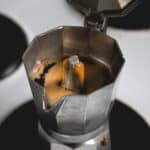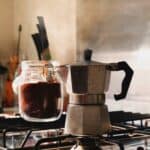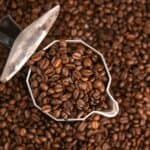17 Key Moka Pot Mistakes You Should Avoid
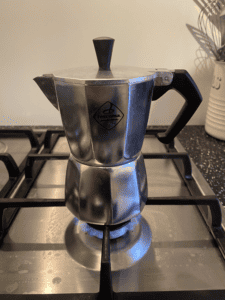
If you are a keen coffee brewer and like to maintain high standards when it comes to coffee, you’ll want to avoid these major Moka pot mistakes at all costs!
The Moka pot is a small and simple coffee brewing device, but that doesn’t make it easy to use by any means. There are plenty of small mistakes that can easily be made when brewing coffee in a Moka pot, and any of them can lead to disaster.
So, let’s take a closer look at what exactly a Moka pot is, and how you can avoid these 17 key, common mistakes when using one.
What is a Moka Pot?
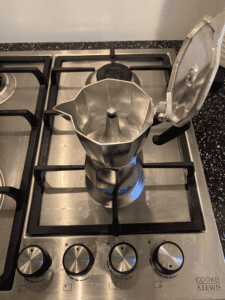
A moka pot is a small coffee brewing device that sits on a stovetop and uses the heat to push pressurized, boiling water through ground coffee. This results in a strong, espresso-like coffee from this inexpensive device. Multiple chambers are used to separate the hot water at the bottom, the coffee basket in the middle, and the coffee collection chamber at the top.
In terms of how a Moka pot operates, it is more similar to an espresso machine or a percolator in the way it uses built up pressure and hot water to drive steam through finely ground coffee.
However, where an espresso machine uses gravity and a downwards flow of hot water to extract coffee from the beans, a Moka pot works in the opposite direction.
Water is added to the bottom chamber of the Moka pot, with fine to medium ground coffee placed in the filter basket which sits on top. Then, the coffee collection chamber is screwed on tightly and the whole thing is placed over a hot stovetop.
The stove heats the bottom of the Moka pot (made from aluminum) which then further boils the hot water above. This generates steam which, as the water boils over, rapidly evaporates through the coffee grounds and pushes hot coffee up through the central spout of the coffee collection chamber.
According to the Moka pot Wikipedia page, the device was first invented in 1933 by Italian designer Alfonso Bialetti, of Bialetti Industries. It then became a staple in Italian kitchens and soon spread throughout Europe.
European migrants (who had been displaced due to the second world war), brought their Moka pots to parts of South America and Australia, further spreading the usage of the device.
You may be wondering where the Moka pot gets its name…
Well, the Moka pot was named after the city of Mocha, in Yemen. Mocha has a rich history of being one of the original coffee trading ports and even drinks like the mocha are thought to also be named after the coastal city.
17 Key Moka Pot Mistakes You Should Avoid
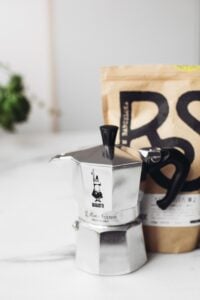
Now we understand exactly what a Moka pot is and how it works, let’s take a closer look at the 17 key Moka pot mistakes you should avoid if you want great coffee time after time.
1. Using The Wrong Size Stovetop
One of the biggest mistakes people make when using a Moka pot is using a stove top that’s the wrong size. Usually, this occurs when the Moka pot is too small for the stovetop, which means the heat from the ring or open flame is not actually directly underneath the base.
This results in heat being unevenly distributed across the Moka pot and leads to water boiling too early. This then increases the pressure too much inside the Moka pot and forces steam through the coffee grounds too quickly. The result is under extracted coffee that’s weak and bitter tasting.
2. Using The Wrong Amount of Water
Unlike many other coffee brewing methods, Moka pots come ready made with the right measurements for coffee and water built into their design. However, there is still room for ambiguity when it comes to how high you should fill up your water chamber.
Using too little water will result in it boiling too quickly, whereas using too much water will mean the boiling process takes too long and the coffee will turn out over-extracted.
You should aim to fill the water chamber of your Moka pot just below the pressure release safety valve.
3. Activating the Safety Valve Unnecessarily
If you underfill your Moka pot and use too little water, you run the risk of overheating it and setting up the safety valve because too much pressure has built up. Whilst most Moka pots are fitted with a safety valve for good reason, you don’t want it going off too early or your coffee won’t brew properly.
What’s more, if you fill the water chamber of your Moka pot up too high so the safety valve is covered, the water will heat up too slowly.
Too much water covering the safety valve risks an uncontrollable pressure build up and your Moka pot may explode!
4. Not Stirring Your Brewed Coffee Before Serving
Another common mistake made by Moka pot users is not stirring their coffee before serving. Since the Moka pot forces pressurized steam up though coffee grounds, the beginning of your brew will be stronger than the end.
This is because more water will be flowing more forcefully through your coffee grounds at the beginning of your brew than at the end when the water starts to evaporate more rapidly and run out.
Therefore, making sure to stir your Moka pot coffee before serving is a key part of getting a consistent taste.
5. Not Tending To Your Moka Pot Throughout The Brew
Whilst the Moka pot is a relatively simple coffee brewing device to use, that doesn’t mean you can just walk away and leave it alone. Don’t forget, you’re heating a metal pot over an open flame or hot hob ring, so it’s important to monitor your Moka pot throughout the brew. Unlike a French press, this is not the sort of coffee brewer that you can just leave for 10 minutes whilst the coffee steeps in hot water.
Moka pots only take a couple of minutes to brew, so make sure to monitor them closely.
Not only is it a good idea to keep an eye on your Moka pot from a safety point of view, but you’ll also be able to stop it from overflowing!
6. Not Cleaning Your Moka Pot
Cleaning your coffee equipment can be a bit of a boring task at times, but it is necessary if you want the best results possible. If you leave ground coffee in your Moka pot for too long you risk it staining the inside of the pot, leaving rancid residual oils on the metal surfaces.
Make sure to clean out your Moka pot with warm soapy water after every brew. It may sound like a long and boring process, but it only has to take a few minutes and it’s totally worth it.
7. Scrubbing Your Moka Pot Too Hard
Whilst cleaning your Moka pot is definitely a good idea, try not to scrub it too hard with a scourer or bristle brush. This can damage the inside of the Moka pot and cause discoloring.
Most Moka pots are made from aluminum and therefore have a protective layer to stop them from becoming damaged. If you scrub your Moka pot too hard with a steel wool brush you may well end up with tiny fragments of metal in your next cup of coffee!
8. Putting Your Moka Pot in the Dishwasher
Another mistake you’ll want to avoid whilst trying to get your Moka pot clean is putting it in the dishwasher. Simply put, the intensity of a dishwasher can ruin your Moka pot thanks to the hot water and chemicals.
You’re much better off using warm soapy water and a cleaning sponge to get those pesky coffee stains off your Moka pot.
9. Storing Your Moka Pot Away Whilst It’s Wet
Once you’re done cleaning your Moka pot, make sure to dry it properly before storing it away in your cupboard. Either towel dry it completely or leave it to air dry for a few hours.
If you store your Moka pot away whilst it’s wet you’ll risk discoloring and oxidation.
10. Using the Wrong Type of Coffee
One way to ensure you don’t get the best out of your Moka pot is to use the wrong type of coffee beans. Ideally, you should aim to buy freshly ground coffee beans with a ‘roasted on’ date label on the bag. This ensures your coffee beans are as fresh as possible and as much original flavor is retained as possible.
If you buy coffee from the supermarket, it will likely already be stale and losing its natural flavor and potency. Therefore, try to buy freshly roasted, specialty coffee if possible.
In terms of specific coffee types to buy, I would recommend going for a medium to dark roasted bean that has a relatively low acidity. Since the Moka pot uses pressurized steam to extract coffee oils from the grounds, it is quite an intense brewing process.
This makes Moka pot coffee often come out quite strong, with a more intense taste than your average pour over.
Therefore, opting for coffee beans with nutty, chocolate and caramel flavor notes will probably be more appealing to most coffee enthusiasts than beans with citrus, wine or fruity notes.
Check out this article for a full breakdown of the best coffee beans to buy for Moka pot in 2023.
11. Not Using The Right Grind Size
Grind size can be a difficult element of coffee brewing to get right. It is easy to end up with over or under extracted coffee by using the wrong grind size for your brewing method of choice.
Generally speaking, the more intense the brewing method (high heat and pressure), the finer you’ll want to grind. For example, Turkish coffee and espresso use very finely ground coffee, whereas a French press or cold brew coffee will use a much coarser grind size.
The best grind size for a Moka pot is medium to fine, sitting just below a medium pour over grind. You don’t want to go as fine as espresso when using a Moka pot, or you may clog up the filter basket. This could lead to an uneven extraction, resulting in watery and bitter coffee, or worse, a Moka pot explosion!
12. Tamping the Moka Pot
Another big no no for when using a Moka pot is tamping the coffee grounds. Tamping finely ground coffee in an espresso machine makes sense, so channeling is minimized and you have a nice even bed of compressed coffee for the highly pressurized steam to flow through.
However, in a Moka pot there is a much lower amount of pressure generated. For reference, most espresso machines operate at approx 9 bar, whereas a Moka pot will only even generate around 1 to 2 bar.
Therefore, tamping your coffee grounds down in your Moka pot’s filter basket will only stop water from flowing up through the central funnel into the coffee collection chamber. Effectively, there won’t be enough force from the boiling water to work against gravity and push through your bed of coffee, since tamping it makes it a lot more dense and compact.
What’s more, the build up of pressure may end up being dangerous if your Moka pot is left on the hob for too long, risking damage to the device.
13. Not Distributing Your Coffee in the Basket
One of the most common ways I see people running their cup of Joe is through an uneven coffee bed. Brewing with an uneven bed of coffee results in channeling, where the pressurized water finds a path of least resistance through one small part of the coffee bed.
This part of the coffee bed gets over extracted, whereas not enough water flows through the rest of the grounds, resulting in an uneven extraction. This produces bitter and watery coffee that simply doesn’t taste great.
This problem can be overcome by distributing your coffee grounds as evenly as possible and getting rid of as many clumps as you can in your Moka pot. Whilst coffee distribution is much more of an issue for making espresso than with any other brewing method, it still applies to Moka pots if you want the best results.
Use a WDT or even a small fork or cocktail stick to break up any major clumps in your bed of ground coffee before applying heat for the best results.
14. Not Using Boiling Water to Preheat Your Moka Pot
Another common mistake you’ll want to avoid when brewing coffee in a Moka pot is filling the water chamber up with cold water at the start of your brew.
This takes a while to heat up on the stove and means you’ll get uneven temperature throughout your brew. This can result in an uneven extraction as well.
The solution is to use boiling water and pour this into your water chamber, so your Moka pot is already preheated and ready to go.
15. Taking Safety Lightly When Brewing
A major mistake that’s easy to make when using a Moka pot is not taking safety seriously. Unlike many other brewing methods, a Moka pot requires a constant heat source to build up enough pressure to force water through the coffee grounds.
Therefore, monitoring your Moka pot throughout the brew, using a tea towel to protect your hands from the hot metal and removing your pot from the heat as soon as it starts to sputter are all great steps to ensure safe brewing.
16. Allowing Your Moka Pot to Deteriorate Over Time
Moka pot maintenance is a key part of ensuring you get consistent results over time. Whilst the majority of your humble Moka pot is made from aluminum and plastic, the gasket at the bottom of the coffee collection chamber is made from rubber.
Over time, the heat and pressure build up in a Moka pot can break down this rubber seal and increase the risk of hot coffee spurting out the side of your Moka pot, or the device not holding pressure as well as it used to.
Make sure to check the rubber gasket regularly, and if you need a replacement, you can find plenty of options on Amazon here.
17. Not Securing Your Moka Pot Tightly Before Brewing
The final mistake that Moka pot users make is not actually screwing the top on tightly enough before placing the device on the stovetop.
Not only will this lead to a reduction in pressure that your Moka pot can generate, but you also risk your coffee leaking or spurting out the side!
Your Moka pot will be hot to touch when using boiling water before the brew, and after applying heat when the brew is done. So, make sure to use a tea towel or over glove when screwing the two chambers together so you don’t burn your hands!
Summary
Overall, brewing coffee in a Moka pot doesn’t have to be complicated, but it is easy to fall foul of the 17 mistakes listed above, simply by not being aware of them!
So, be sure to follow this guide and avoid these common Moka pot mistakes at all costs.
Check out these articles for more coffee brewing tips:
Moka Pot Mistakes Frequently Asked Questions
If your Moka pot is sputtering this means the heat is too high and you risk over extracting your coffee. Simply remove your Moka pot from the heat and run the base under a cold tap to halt the brewing process.
If you use too much heat when brewing coffee in a Moka pot, you can end up with burnt coffee that tastes bitter and unpleasant. This is easily done and is the reason why Moka pots need to be closely monitored throughout the brew.
If you have used stale beans, ground your coffee too coarsely, applied too much heat or simply used a dirty Moka pot, your coffee could come out tasting bad!
When you hear your Moka pot gurgling or can see the flow of coffee reaching the top of the coffee collection chamber (if you leave the lid open), your Moka pot is done brewing.

